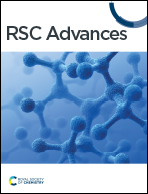Synthesis, characterization and properties of sulfate-modified silver carbonate with enhanced visible light photocatalytic performance†
Abstract
Sulfate-modified Ag2CO3 was successfully synthesized via a simple precipitation method. Its visible light photocatalytic performance against the removal of Orange G was found to be significantly enhanced in comparison with the one of pure Ag2CO3. While SO42−-Ag2CO3 ensured a removal efficiency of 100% of OG within 30 min, the unmodified Ag2CO3 exhibited a degradation threshold at hardly 60%. Likewise, the degradation rate constant in the presence of SO42−-Ag2CO3 photocatalyst was assessed to be twice that determined upon the involvement of pristine Ag2CO3. Furthermore, Total Organic Carbon (TOC) measurements evidenced the occurrence of a quasi-total mineralization of the dye pollutant upon the use of SO42−-Ag2CO3 photocatalyst. Scavenger experiments highlighted the dominant role of photo-induced h+ along with ˙O3− ozonide radicals in the OG photocatalytic oxidation mechanism. Reuse cycles revealed that the modification by SO42− is a promising route to improve the stability of silver carbonate against photocorrosion. All these improvements could be ascribed to electronic transfer from the upper SO42− HOMO to the lower Ag2CO3 conduction band.



 Please wait while we load your content...
Please wait while we load your content...